
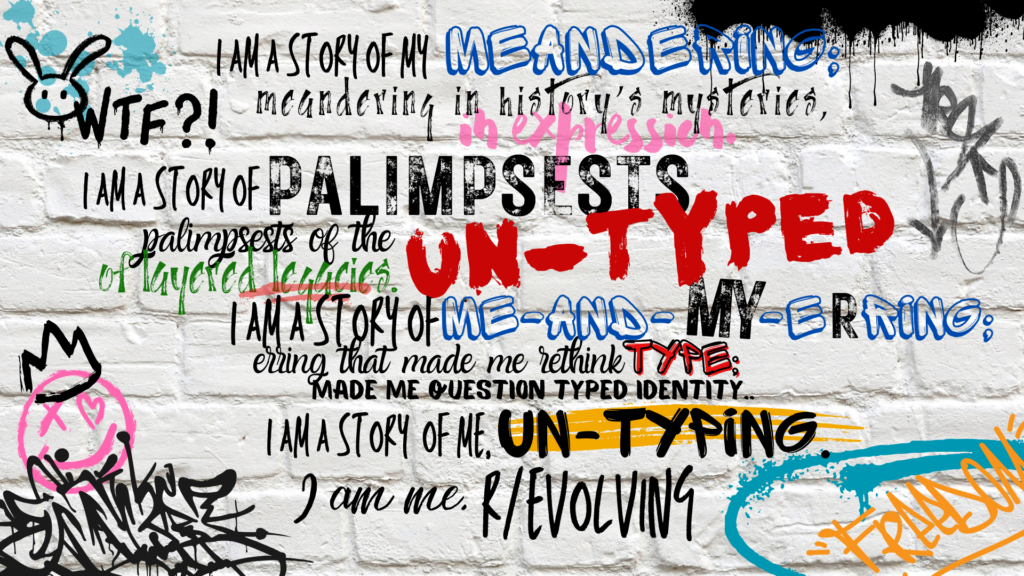
My story re-begins on the streets of Toronto, a cityscape where the concrete monochrome imposes itself, typing over histories, legacies, identities, lives, desires. But the concrete cannot contain the vibrant type-scape of vintage shops, cozy restaurants, painted streets, of sidewalks pulsing with arrivals, leavings, and returns.
But so what if they found something more damaging? What if, what they already know is still happening? What if their “identities,” their “languages,” and their “histories” that shifted once are shifting still—blotting out their voices? Will choosing to “pretend to know nothing” help? Will silence help? Will re-sounding have consequences?
In my meanderings, the streets of Toronto speak to me, the walls speak to me. The concrete walls and brick walls and makeshift walls pulse with artistic expression. But there are other walls—walls that were once there and are now effaced. Walls of palimpsests where a louder voice overwrites an Other. Walls that appear and those that disappear.
Whitewashed.
Each visual shifts the earth beneath me, inside me, calling out to me, whispering, “Listen. Listen to what you see: Have we not been typed and un-typed and typed enough?”
In a whirlwind, Toronto blows me away. Physically, I am still standing on the pavement, blocking the way for angry pedestrians, who curse and probably give me a finger or two.
But I see nothing.
I hear nothing.
My mind rushes.
It rushes towards words and letters in different typefaces that pulse out from these walls. I extend my arms, my eyes, my ears to touch, to see, to listen to the dark, bold “N”, typed.

It calls. It wants me to see it, to listen to it, to know its urgency. But how can I know?
I see walls full of type. I see types bigger and bolder appearing through others. I see type obliterating type, disappearing. I press my ears to the walls to listen. There is a cacophony underneath, trying to break the painted iron maiden. But the sounds are too tired, too trodden, broken. I can only hear the dominion, the dominant.
But I won’t give up. I will keep searching, seeing, and listening.
In my quest for listening, I read an article about typographic imperialism called “Broken is Word” by Andrea Stanton, where she writes about how typefaces are often designed based on aesthetics that reflect our cultural assumptions without any real consideration of underlying cultural history.
Am I perpetuating typographic imperialism? Am I ignoring—no refusing to see—the underlying cultural history? Am I Othering? I couldn’t, I thought. I am an Other. How could I not see the palimpsests of history behind type? How could I not see another—an Other?
I thought of the walls, the cacophony, the silence. Was this cacophony the sound of the untyped? Was the disappearing type telling me something—telling the world something—telling you something? Have you thought about it? Have you written over an Other?
I begin to understand what “Listen to what you see” means. I have been looking at typefaces but not listening to them. I have been seeing expression, but not hearing the impression of layers of centuries of palimpsestic over-writing, colonialism, laid over, written over,
agaiN and agaiN and agaiN…
Have I, have you, has Toronto considered the residual remains?
Carl Dair said, “Each [person] in his own time, often with crude tools poised against resisting surfaces, tried to make the written record the epitome of the art and culture of his own period. Bone against clay, chisel against stone, brush against silk, quill against parchment, lead against paper, each tool made its characteristic mark, and each surface received the impression in its characteristic way.” —Design with Type
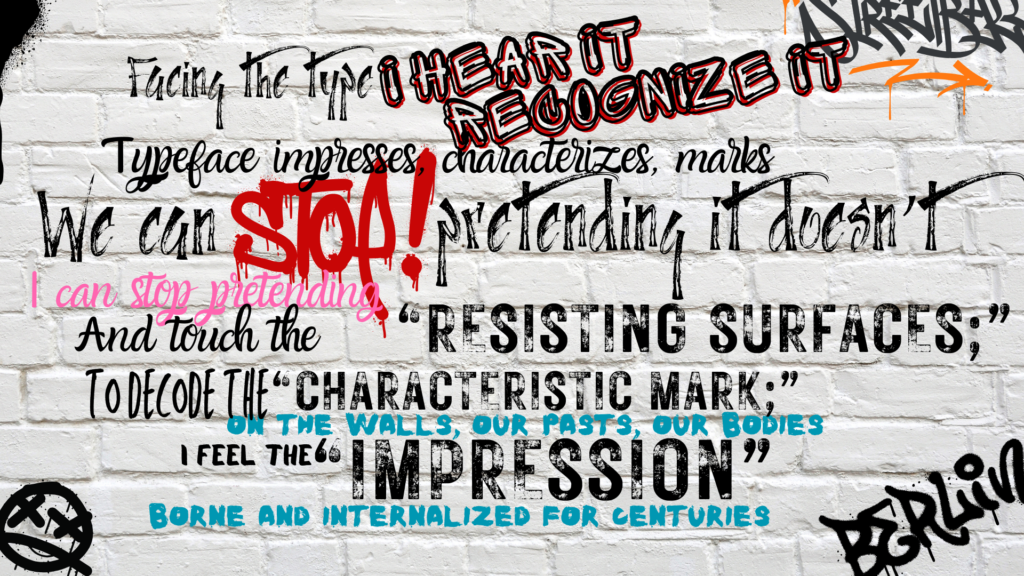
I see now why “pretending” can be about survival – but at what cost, I now ask myself. The answer is never easy, and time passes as the writing on the wall remains in my mind.
What if the cacophony is a “characteristic mark”—an “impression”—of history, of legacy? What if they are trapped in palimpsestic imperialism? What did I really see that day on the streets of Toronto? The answer was there but seemed just a little out of reach, perhaps because I, too, have been “pretending to know nothing”…what residual remains, what marks—typed or untyped—perhaps “untraceable” have been overwritten on my own body?
But life goes on. I do what I’m supposed to do. I meet friends, I talk to family. I go to the theatre to watch Jurassic World Dominion.
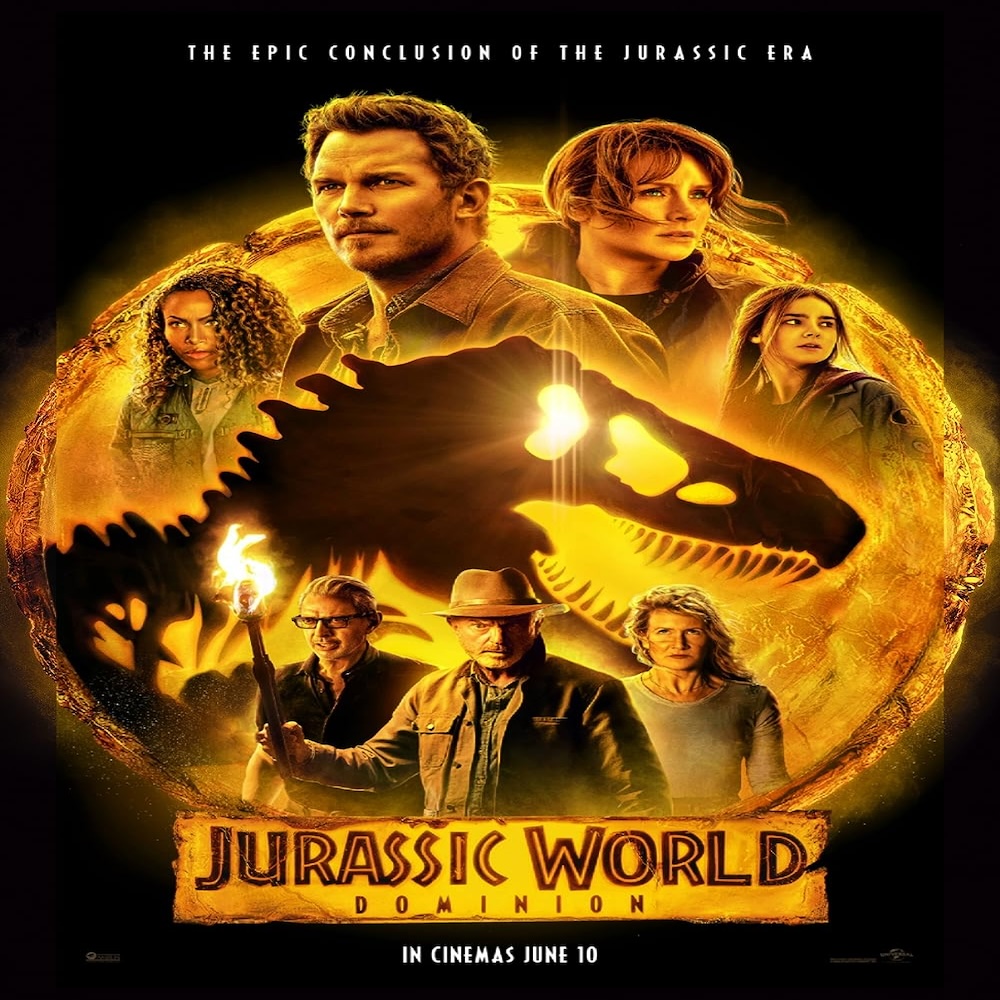
The black and gold film poster appears on the big iMAX screen, and the title screams through the “resisting surface” of the screen. The title’s typeface looks almost like the “N” I saw on the street. I Google the typeface, and it turns out, it is Neuland – a typeface used as an advertising font for products like tobacco and cotton—colonial products associated with Trans-Atlantic slavery—in 1900s America—a symbol of slavery.
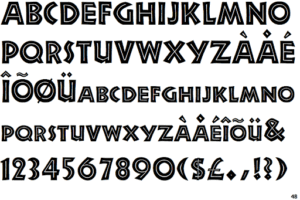
The film adapted the font and embodied its qualities that suggested “jungle,” “safari,” and “adventure”—qualities that suggested Africana—qualities associated with the “New World”.
Time seems to stop.
I look around for shock but find awe, I look for resentment but see pleasure. I look for anger but find delight. I guess the darkness of history cannot penetrate the rose-tinted glasses. I sit through the film in a daze, wondering if no one knows the legacy hiding behind the CGI dinosaurs. Did no one make meaning in the typeface?
Maybe all my others pretend to know nothing because knowing is sometimes “too much”; Dionne Brand is right—“what if [we] found out something even more damaging?”
I feel broken, typed over, Othered. But I don’t want to be broken, typed over or typed at all. I am an Other, but I’m not broken. I am an Other, and I will break the iron maiden. I will release the cacophony.
I will un-type.
I see the N, aNew.
It calls.
stops.
alarms.
The N is silent, yet it screams. It inscribes impressions in our body, sculpts our identity, and defines us.
The N transports histories, lived experiences, trauma, joy, and freedom through the palimpsests of centuries. We must use it to fight, to resist the imperialist impressions that imprison our legacies.
Neuland called me on the street and stopped me in the theatre. Its legacy alarmed me, and I finally began to listen.
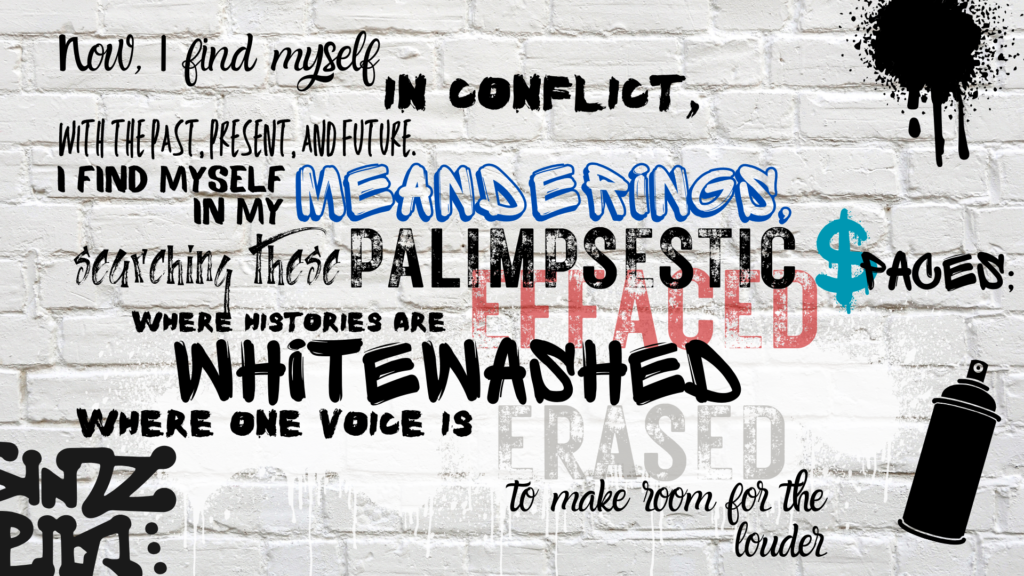
I find myself
confronting me-and-my-e[r]rings,
to unlearn and relearn, to re-type, re-write, resist.
I finally find myself
making meaning
of the silenced and the resounding.
to make all our Others louder, bolder.
I find myself
R/Evolving.
But is that enough?
Is it enough that I change while Toronto dusts histories behind palimpsests? Is it enough that I recognize the marks on the walls, on our bodies, on our pasts while Toronto “pretends to know nothing”? Is it enough for me to feel the “impression” that we have borne for centuries while Toronto erases T’karonto?
No. We must know. Re-know.
You must journey through the palimpsests.
You must listen.
You must unlearn and relearn,
to re-sound the silenced,
to re-write, resist,
R/Evolve
Un-type.
Deea Deb is a fourth-year English & Professional Writing student at York University. She is a Dean’s Scholar and has received multiple awards in digital authorship. She has worked in communications for the past 16 years. Deea is passionate about Design Writing – how design and writing coalesce to create provocative communication. In her spare time, she loves reading fantasy fiction and hoarding stationery.
